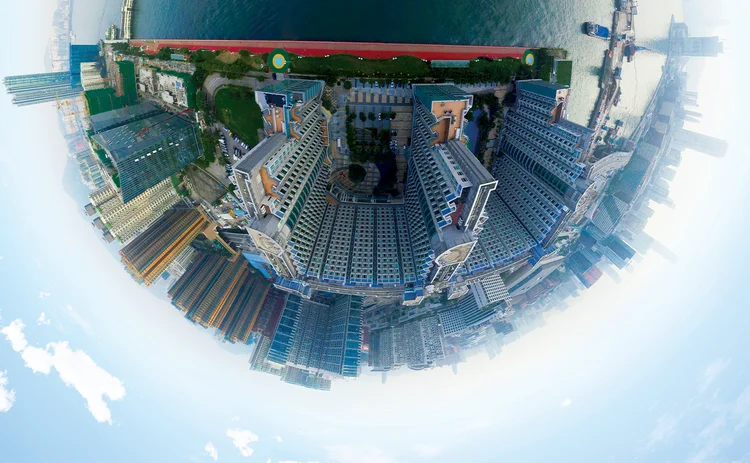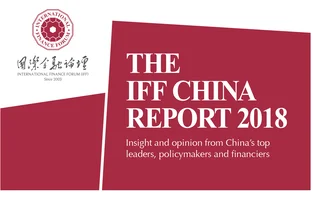
A world turned upside down
The shortcomings and exaggerations of the success of neoliberalism have been exposed, and the developing world’s students of globalisation have now become its teachers. As the West flounders, a confident China is now the beacon for liberalisation, globalisation and a ‘third way’, explains Di Dongsheng, vice-dean at the School of International Studies, Renmin University of China


What changes has the financial crisis wrought over the past decade? When the crisis broke out in 2007–2008, US financial commentators such as Bill Gross, the American investor and fund manager, known as ‘the king of bonds’, foresaw three major themes in the post-crisis era: greater regulation, deleverage and deglobalisation. To what extent have these predictions come true?
Regulation was applied – irresolutely – and failed. The real culprits of the financial crisis were not jailed but exonerated. They successfully preserved their freedom – and their wealth – with some even retaining their positions.
High leverage in the US and Europe over the past decade has merely been transferred rather than decreased. This leverage first forced the public sector to significantly expand its debt to incorporate loans and deficits diverted by the financial and private sectors; the US and European countries then capitalised on the privileges of the US dollar and the euro to push the debt interest rates down to zero or negative, turning trillions of dollars of deficit into high inflation in the global periphery.

Of Gross’s three predicted themes, at that time, only deglobalisation was actually happening. Populism, isolationism and protectionism replaced the global spirit of ‘opening‑up’, pluralism, equality and innovation. The election of Donald Trump as US president and the UK’s decision in 2016 to leave the European Union highlight the major Western powers’ repudiation of the ideas of globalisation they had endorsed since the term was first conceived in 1979. Neoliberal globalisation has been abandoned by its own creators and has become a discarded theory in the 21st century.
A world in reverse gear
The world rapidly went into decline in the decade following the financial crisis, when the students of globalisation became its teachers and the developing countries that had previously followed the West’s guidance in promoting globalisation began to set the benchmark for its implementation. President Xi Jinping advocated the benefits of the progressive opening of China’s markets at the World Economic Forum annual meeting in Davos in January 2018. He also supported implementation of multilateral governance systems and global climate governance, and is now encouraging innovation and environmental protection, managed through huge financial cost and policy reform. The International Monetary Fund’s (IMF’s) managing director, Christine Lagarde, has found more common ground with Chinese leaders than those in the US. China seeks a larger share, a louder voice and greater responsibilities in the IMF, whereas at least half of US citizens view such multinational institutions as inefficient and burdensome. The IMF’s economists are no longer as dedicated to the liberalisation of capital accounts, although their Chinese counterparts are struggling to inject flexibility and autonomy into exchange and interest rates, and to prudently but firmly release funds for its capital projects.
The IMF’s constitution stipulates that its headquarters should be located in the member country with the largest economy. In light of the growth of the Chinese economy, adjustments in statistical methods and the prospect of exchange rate appreciation, it is believed that, as early as 2021, a serious decision will need to be made on the location of the second headquarters of the IMF and the World Bank – slated to be either Pudong in Shanghai or the Xiong’an New Area south of Beijing.
In a world turned upside down, an interesting reversal has occurred in energy and emissions reduction. A decade ago, some in China were dubious of the policy of ‘going green’. Its progress, driven by the EU, was conducive to the EU’s global moral leadership and its new energy and environmental industries, yet would deprive Chinese people south of the Huai River of winter heating. However, with the improvement of China’s energy saving and environmental protection policies, and the development in new energy industries, this doubt waned. However, it has re-emerged in the US, where it is often claimed that China conspires to push for green energy conservation and emissions reduction merely to attain industrial benefits, that global warming is believed to be pseudoscience – or ‘fake news’ – and that only more coal and oil can upgrade the economic structure in the US.
In China, perhaps the most enduring changes since 2008 are those in its industrial structure and its competitiveness. Ten years ago, China’s GDP was less that of Japan, and ranked third in the world. China’s export commodities were predominantly labour-
intensive, and its so-called ‘high-tech’ products were the assembly of high-tech components of other countries – such as the assembly export industry of Apple mobile phones in Foxconn in Taiwan. But today, most consumer goods in US supermarkets are no longer sourced from China, but Vietnam, Indonesia, Bangladesh and even Africa. China has made great strides, ascending several steps in the industrial ladder. In the Apple mobile phone supply chain, Chinese manufacturers are not simply assemblers, but providers of dozens of important components, with the previously commonplace tag of ‘made in China’ gradually being transformed into ‘made by China’. China’s self-branded and patented products have proved their own competitiveness in many fields, including electric vehicles, smartphones, drones and high-speed trains.
China is also playing an enhanced role in the fields of innovation and the internet. There used to be a joke that the World Wide Web could be divided into two parts: the global network and the Chinese internet. However, as a consequence of current global internet development and a lack of governance, China’s policies and its reasons for their implementation may prove to be reasonable. Around 200 years ago, the advent of newspapers and other mass media attempted to shape the opinion of the majority of literate people to mainstream ideologies, resulting in ‘mass politics’. Now, the traditional media is marginalised by network information, and individuals have become the communicators and processors of information rather than recipients, breaking down control by media elites. A fierce split in mainstream ideology has accelerated the collapse of a Western social consensus. In China, despite the drawbacks of information control and censorship, the proliferation of fake news has had little effect, and the social consensus is relatively stable.
China plays catch-up
China’s development in IT is also proving successful in business and industry – China, the former protectionist, imitator and isolator in the internet field, is shedding its passive status and beginning to export its network services and brands to the world. Most countries are not developing seriously competitive brands and businesses in the network economy and artificial intelligence; only China’s Baidu, Alibaba and Tencent can compete with the US internet giants and, as internet applications move to mobile platforms, China’s internet companies have the potential to overtake them. More than one European student in China has told the author that, on their return to Europe, they realised how old-fashioned, unsophisitcated and insecure shopping with cash and credit cards is. An IT entrepreneur in Shenzhen told the author that when he visited Silicon Valley for three months to explore new ideas, he found that, on his return to Shenzhen, the pace of innovation and technological development meant that he was already behind the times, and his knowledge and ideas were outdated.
After a decade of negative and ultra-low interest rates, Western economies are now seeing light at the end of the tunnel of the post-crisis era. For example, the Bank of Japan has started to trim purchases of long-term government bonds. Over the past 10 years, what have the US, Japan and Europe relied on most to lift them out of the post-crisis era? The answer is probably their central banks. Paradoxically, the central banks of the US, Japan and Europe have dramatically expanded their balance sheets by printing money to bail out insolvent financial institutions and the public sector – but their exchange rates have not significantly depreciated. Countries struggling with significant currency devaluation include India, Brazil, Russia and other developing economies. In 1971, after the ‘Nixon shock’ – when then-US President Richard Nixon undertook a number of economic measures, including cancelling the direct international convertibility of the US dollar to gold – then-US Treasury secretary John Connally declared: “This is our currency, but it is your problem.”
Debt borrowing in its own currency is a privilege enjoyed only by developed countries; China is now working hard to join that club by converting its disadvantaged position in this no (hard) anchor currency system through the internationalisation of the renminbi.
The change in China’s status over the past decade has not made it more liberal, but more confident of its own civilisation and system. Chinese politicians and intellectuals have begun to realise the shortcomings and exaggerations of Western neoliberalism. China learned first from the former Soviet Union that totalitarianism would strengthen China rapidly. From the 1980s onwards, China learned from the US that the free-market model would make China prosperous. Yet China – the student of these policical and economic policies – found that its teachers were not perfect: the Soviet Union was too poor and despotic, while the US is too chaotic. Now, China turns its eyes to Europe, this time not looking up, but head-on. China hopes to revive the ancient Silk Route together with the major European powers and explore the ‘third way’ of integrating market efficiency and government control. Can globalisation gain a new life? Europe and China hold the key.
Only users who have a paid subscription or are part of a corporate subscription are able to print or copy content.
To access these options, along with all other subscription benefits, please contact info@centralbanking.com or view our subscription options here: subscriptions.centralbanking.com/subscribe
You are currently unable to print this content. Please contact info@centralbanking.com to find out more.
You are currently unable to copy this content. Please contact info@centralbanking.com to find out more.
Copyright Infopro Digital Limited. All rights reserved.
As outlined in our terms and conditions, https://www.infopro-digital.com/terms-and-conditions/subscriptions/ (point 2.4), printing is limited to a single copy.
If you would like to purchase additional rights please email info@centralbanking.com test test test
Copyright Infopro Digital Limited. All rights reserved.
You may share this content using our article tools. As outlined in our terms and conditions, https://www.infopro-digital.com/terms-and-conditions/subscriptions/ (clause 2.4), an Authorised User may only make one copy of the materials for their own personal use. You must also comply with the restrictions in clause 2.5.
If you would like to purchase additional rights please email info@centralbanking.com test test test







